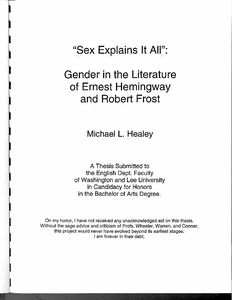| dc.rights.license | In Copyright | en_US |
| dc.creator | Healey, Michael Lawrence | |
| dc.date.accessioned | 2023-10-20T18:02:07Z | |
| dc.date.available | 2023-10-20T18:02:07Z | |
| dc.date.created | 2000 | |
| dc.identifier | WLURG038_Healey_thesis_2000 | |
| dc.identifier.uri | https://dspace.wlu.edu/handle/11021/36571 | |
| dc.description.abstract | Gender is merely an attribute, rather than the single determining factor of one's identity, yet Hemingway and Frost both devised their own distinctly masculine personality -- a public image which became progressively more important to these writer as their celebrity increased. The relationship between Hemingway's and Frost's respective biographies and works provides an unexpected forecast of Judith Butler's agency theory: "Gender is always a doing, though not a doing by a subject who might be said to preexist the deed" (25). Thus, just as characters such as Jake Barnes or the Hill-Wife assert their own genders through individual behavior, so do Frost and Hemingway create complex gendered identities in the public sphere. Both writers' fame forces them to consider not only their creative output, but also their personae, as essential to the construction of a gendered self. I argue that their works ultimately affirm the flexible nature of gender, as opposed to a constrictive male/female binary, frequently depicting characters who are aware of their own potential to create a gendered identity. Chapter One, "Choice and the Feminine Sensibility," explores the notion of a gender-influenced language, proposing that speech is governed by specifically male or female codes and assumptions. Meaningful interaction between the sexes might then seem all but impossible, and both Frost and Hemingway accordingly explore the implications of sexually determined communication through a number of works in which a woman's reaction to a climactic situation is clearly influenced by her own conception of gender identity. . . . The second chapter, "Marriage and 'Home,"' furthers this notion of choice in its conception of literary marriages in Frost and Hemingway, suggesting that one must relinquish a certain gendered lifestyle if one is to establish a home, and that language (as in Chapter One) is a crucial element in that equation. . . . This exploration of a gendered choice expressed in terms of language modulates in the third chapter, "Sexual Performance," as the very act of writing comes to the forefront of the argument. While the relatively unsophisticated characters of "Up in Michigan" and "The Subverted Flower" perform according to the potentially dangerous rubric of a traditional male/female binary, a more sophisticated conception of gender emerges through figures of the writer. . . . Finally, the concluding chapter examines the relationship between "Gender and the Creative Impulse," attempting to locate a correlation between these works and the writers'
own ideas of gender representation. [From Introduction] | en_US |
| dc.format.extent | 100 pages | en_US |
| dc.language.iso | en_US | en_US |
| dc.rights | This material is made available for use in research, teaching, and private study, pursuant to U.S. Copyright law. The user assumes full responsibility for any use of the materials, including but not limited to, infringement of copyright and publication rights of reproduced materials. Any materials used should be fully credited with the source. | en_US |
| dc.rights.uri | http://rightsstatements.org/vocab/InC/1.0/ | en_US |
| dc.subject.other | Washington and Lee University -- Honors in English | en_US |
| dc.title | "Sex explains it all": Gender in the Literature of Ernest Hemingway and Robert Frost | en_US |
| dc.type | Text | en_US |
| dcterms.isPartOf | WLURG038 - Student Papers | en_US |
| dc.rights.holder | Healey, Michael Lawrence | en_US |
| dc.subject.fast | Hemingway, Ernest, 1899-1961 | en_US |
| dc.subject.fast | Frost, Robert, 1874-1963 | en_US |
| dc.subject.fast | Criticism, interpretation, etc. | en_US |
| dc.subject.fast | Gender identity in literature | en_US |
| local.department | English | en_US |
